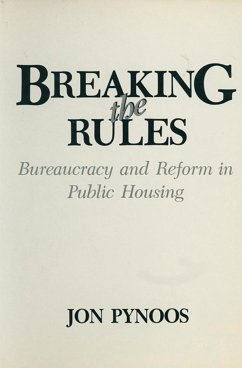- Gebundenes Buch
- Merkliste
- Auf die Merkliste
- Bewerten Bewerten
- Teilen
- Produkt teilen
- Produkterinnerung
- Produkterinnerung
This is a study of how a bureaucracy allocates a commodity or a service in this case, public housing. In the broadest sense, it seeks to understand how bureaucrats try to resolve two often conflicting goals of regulatory justice: equity (treating like cases alike on the basis of rules) and respon siveness (making exceptions for persons whose needs require that rules be stretched). It analyzes the extent to which such factors as bureaucratic norms, the task orientation of workers, third-party pressure, and outside intervention affect staff members' use of discretion. Many of the rules under…mehr
Andere Kunden interessierten sich auch für
![Cities of the Mind Cities of the Mind]() Lloyd Rodwin (ed.) / Robert M. HollisterCities of the Mind232,99 €
Lloyd Rodwin (ed.) / Robert M. HollisterCities of the Mind232,99 €![The Bureaucratic Labor Market The Bureaucratic Labor Market]() Thomas A. DiPreteThe Bureaucratic Labor Market154,99 €
Thomas A. DiPreteThe Bureaucratic Labor Market154,99 €![Liberating Systems Theory Liberating Systems Theory]() Robert L. FloodLiberating Systems Theory116,99 €
Robert L. FloodLiberating Systems Theory116,99 €![Segmented Labor, Fractured Politics Segmented Labor, Fractured Politics]() William FormSegmented Labor, Fractured Politics104,99 €
William FormSegmented Labor, Fractured Politics104,99 €![Regional Policy in a Changing World Regional Policy in a Changing World]() Niles HansenRegional Policy in a Changing World154,99 €
Niles HansenRegional Policy in a Changing World154,99 €![Social Contracts and Economic Markets Social Contracts and Economic Markets]() J. R. BlauSocial Contracts and Economic Markets77,99 €
J. R. BlauSocial Contracts and Economic Markets77,99 €![Ethics in Business and Society Ethics in Business and Society]() Ethics in Business and Society116,99 €
Ethics in Business and Society116,99 €-
-
-
This is a study of how a bureaucracy allocates a commodity or a service in this case, public housing. In the broadest sense, it seeks to understand how bureaucrats try to resolve two often conflicting goals of regulatory justice: equity (treating like cases alike on the basis of rules) and respon siveness (making exceptions for persons whose needs require that rules be stretched). It analyzes the extent to which such factors as bureaucratic norms, the task orientation of workers, third-party pressure, and outside intervention affect staff members' use of discretion. Many of the rules under consideration were intended by federal officials to achieve such programmatic objectives as racial desegregation and housing for the neediest; in this regard, the study is also an examination of federal-local relationships. Finally, the study examines how the use of discretion changes over time as an agency's mission shifts and reforms are attempted. This book is directed at the audience of administrators of programs who offer services to the public and struggle with how to allocate them. The book is also intended for those concerned with housing policy, partic ularly the difficult problems of whom to house. Finally, it is hoped that students of public management, social welfare, government, and urban planning, who are interested in how public policy is administered through a bureaucracy, will find the book insightful. The case chosen for study is the Boston Housing Authority.
Produktdetails
- Produktdetails
- Environment, Development and Public Policy: Cities and Development .
- Verlag: Springer, Berlin
- 1986.
- Seitenzahl: 221
- Erscheinungstermin: 31. Oktober 1986
- Englisch
- Abmessung: 234mm x 160mm x 24mm
- Gewicht: 500g
- ISBN-13: 9780306423024
- ISBN-10: 0306423022
- Artikelnr.: 27640078
- Environment, Development and Public Policy: Cities and Development .
- Verlag: Springer, Berlin
- 1986.
- Seitenzahl: 221
- Erscheinungstermin: 31. Oktober 1986
- Englisch
- Abmessung: 234mm x 160mm x 24mm
- Gewicht: 500g
- ISBN-13: 9780306423024
- ISBN-10: 0306423022
- Artikelnr.: 27640078
One: Bureaucracy and Public Housing.- Uses of Discretion.- Federal-Local Relationships: Clarity of Rules.- The Task Orientation of Street-Level Bureaucrats.- The Norms of the Staff.- The Influence of Third Parties.- Outside Intervention, Changing Conditions, and Reform.- Summary.- Two: The Emergence of Rules.- Locally Originated Rules.- The Happy Years: Patronage and Screening.- The Middle Years: Segregating New Clients.- Reform: Desegregating the Projects.- New Rules and Regulations.- Nationally Originated Rules.- Federal Intervention.- Response to the HUD Plan.- Another Reform: Leadership.- Conclusion.- Three: Breakdown of the Rule System.- Measurement Problems.- Working Conditions.- Information Gathering.- Division of Labor.- Crisis Situations.- Poor Vacancy Reporting.- Low Morale.- Priority Reduction and Abrogation of Power.- Client Rejection and Goal Failure.- Project Variation.- Applicant Preferences.- Shortcomings of the 1-2-3 Rule.- Staff Circumvention of the Rule.- Conclusion.- Four: Discretion, Staff Norms, and Outcomes.- Staff Discretion.- Bureaucratic Types and the Use of Discretion.- Traditionalists.- Reformers.- Survivalists.- Avoiders.- Outcomes.- Conclusion.- Five: The Influence of Third-Party Sponsors.- Referrals.- Information.- Access.- Service.- Advocacy.- Social Agencies.- Politicians.- Board Members and the Administrator.- Conclusion.- Six: Project-Level Discretion.- Managerial Practices for Controlling Admissions at the Projects.- Background of Managers and Nature of the Job.- Project-Level Control Mechanisms.- Situation as a Determinant of Discretion.- Project Profiles.- The Influence of Situation at Mary Ellen McCormick.- The Influence of Situation at Columbia Point.- Personal Style as a Determinant of Outcome.- Traditional Style.- Reform Style.- Conclusion.- Seven: Federal Intervention: HUD Monitoring, Feedback, and Evaluation.- Monitoring the BHA.- Written Reports.- Regular Audits.- Unsolicited BHA Feedback.- Public Channels.- Special Audits.- Evaluation.- HUD s Power.- Conclusion.- Eight: The Later Years: Court-Initiated Reform Efforts.- Limited Intervention.- Improving the Tenant Selection, Assignment, and Transfer System.- Improving Efficiency.- Desegregating Developments.- Marketing Public Housing.- Increasing Managerial Discretion.- Increasing Screening.- Outcomes of Limited Intervention.- The Receivership.- Management Reorganization.- Screening.- Promoting Fair Housing.- Broad Range of Income.- Tenant Empowerment.- The End of Receivership.- Conclusion.- Nine: Summary and Implications.- Conditions for Reform.- Whom Shall Public Housing Serve?: The Influence of Socioeconomic Conditions.- Regulatory Justice: Uses of Discretion.- Federal-Local Relationships: Clarity of Rules.- The Influence of Third Parties.- The Power of Street-Level Bureaucrats.- Client Empowerment.- The Privatization of Public Housing.- General Implications.
One: Bureaucracy and Public Housing.- Uses of Discretion.- Federal-Local Relationships: Clarity of Rules.- The Task Orientation of Street-Level Bureaucrats.- The Norms of the Staff.- The Influence of Third Parties.- Outside Intervention, Changing Conditions, and Reform.- Summary.- Two: The Emergence of Rules.- Locally Originated Rules.- The Happy Years: Patronage and Screening.- The Middle Years: Segregating New Clients.- Reform: Desegregating the Projects.- New Rules and Regulations.- Nationally Originated Rules.- Federal Intervention.- Response to the HUD Plan.- Another Reform: Leadership.- Conclusion.- Three: Breakdown of the Rule System.- Measurement Problems.- Working Conditions.- Information Gathering.- Division of Labor.- Crisis Situations.- Poor Vacancy Reporting.- Low Morale.- Priority Reduction and Abrogation of Power.- Client Rejection and Goal Failure.- Project Variation.- Applicant Preferences.- Shortcomings of the 1-2-3 Rule.- Staff Circumvention of the Rule.- Conclusion.- Four: Discretion, Staff Norms, and Outcomes.- Staff Discretion.- Bureaucratic Types and the Use of Discretion.- Traditionalists.- Reformers.- Survivalists.- Avoiders.- Outcomes.- Conclusion.- Five: The Influence of Third-Party Sponsors.- Referrals.- Information.- Access.- Service.- Advocacy.- Social Agencies.- Politicians.- Board Members and the Administrator.- Conclusion.- Six: Project-Level Discretion.- Managerial Practices for Controlling Admissions at the Projects.- Background of Managers and Nature of the Job.- Project-Level Control Mechanisms.- Situation as a Determinant of Discretion.- Project Profiles.- The Influence of Situation at Mary Ellen McCormick.- The Influence of Situation at Columbia Point.- Personal Style as a Determinant of Outcome.- Traditional Style.- Reform Style.-Conclusion.- Seven: Federal Intervention: HUD Monitoring, Feedback, and Evaluation.- Monitoring the BHA.- Written Reports.- Regular Audits.- Unsolicited BHA Feedback.- Public Channels.- Special Audits.- Evaluation.- HUD's Power.- Conclusion.- Eight: The Later Years: Court-Initiated Reform Efforts.- Limited Intervention.- Improving the Tenant Selection, Assignment, and Transfer System.- Improving Efficiency.- Desegregating Developments.- Marketing Public Housing.- Increasing Managerial Discretion.- Increasing Screening.- Outcomes of Limited Intervention.- The Receivership.- Management Reorganization.- Screening.- Promoting Fair Housing.- Broad Range of Income.- Tenant Empowerment.- The End of Receivership.- Conclusion.- Nine: Summary and Implications.- Conditions for Reform.- Whom Shall Public Housing Serve?: The Influence of Socioeconomic Conditions.- Regulatory Justice: Uses of Discretion.- Federal-Local Relationships: Clarity of Rules.- The Influence of Third Parties.- The Power of Street-Level Bureaucrats.- Client Empowerment.- The Privatization of Public Housing.- General Implications.
One: Bureaucracy and Public Housing.- Uses of Discretion.- Federal-Local Relationships: Clarity of Rules.- The Task Orientation of Street-Level Bureaucrats.- The Norms of the Staff.- The Influence of Third Parties.- Outside Intervention, Changing Conditions, and Reform.- Summary.- Two: The Emergence of Rules.- Locally Originated Rules.- The Happy Years: Patronage and Screening.- The Middle Years: Segregating New Clients.- Reform: Desegregating the Projects.- New Rules and Regulations.- Nationally Originated Rules.- Federal Intervention.- Response to the HUD Plan.- Another Reform: Leadership.- Conclusion.- Three: Breakdown of the Rule System.- Measurement Problems.- Working Conditions.- Information Gathering.- Division of Labor.- Crisis Situations.- Poor Vacancy Reporting.- Low Morale.- Priority Reduction and Abrogation of Power.- Client Rejection and Goal Failure.- Project Variation.- Applicant Preferences.- Shortcomings of the 1-2-3 Rule.- Staff Circumvention of the Rule.- Conclusion.- Four: Discretion, Staff Norms, and Outcomes.- Staff Discretion.- Bureaucratic Types and the Use of Discretion.- Traditionalists.- Reformers.- Survivalists.- Avoiders.- Outcomes.- Conclusion.- Five: The Influence of Third-Party Sponsors.- Referrals.- Information.- Access.- Service.- Advocacy.- Social Agencies.- Politicians.- Board Members and the Administrator.- Conclusion.- Six: Project-Level Discretion.- Managerial Practices for Controlling Admissions at the Projects.- Background of Managers and Nature of the Job.- Project-Level Control Mechanisms.- Situation as a Determinant of Discretion.- Project Profiles.- The Influence of Situation at Mary Ellen McCormick.- The Influence of Situation at Columbia Point.- Personal Style as a Determinant of Outcome.- Traditional Style.- Reform Style.- Conclusion.- Seven: Federal Intervention: HUD Monitoring, Feedback, and Evaluation.- Monitoring the BHA.- Written Reports.- Regular Audits.- Unsolicited BHA Feedback.- Public Channels.- Special Audits.- Evaluation.- HUD s Power.- Conclusion.- Eight: The Later Years: Court-Initiated Reform Efforts.- Limited Intervention.- Improving the Tenant Selection, Assignment, and Transfer System.- Improving Efficiency.- Desegregating Developments.- Marketing Public Housing.- Increasing Managerial Discretion.- Increasing Screening.- Outcomes of Limited Intervention.- The Receivership.- Management Reorganization.- Screening.- Promoting Fair Housing.- Broad Range of Income.- Tenant Empowerment.- The End of Receivership.- Conclusion.- Nine: Summary and Implications.- Conditions for Reform.- Whom Shall Public Housing Serve?: The Influence of Socioeconomic Conditions.- Regulatory Justice: Uses of Discretion.- Federal-Local Relationships: Clarity of Rules.- The Influence of Third Parties.- The Power of Street-Level Bureaucrats.- Client Empowerment.- The Privatization of Public Housing.- General Implications.
One: Bureaucracy and Public Housing.- Uses of Discretion.- Federal-Local Relationships: Clarity of Rules.- The Task Orientation of Street-Level Bureaucrats.- The Norms of the Staff.- The Influence of Third Parties.- Outside Intervention, Changing Conditions, and Reform.- Summary.- Two: The Emergence of Rules.- Locally Originated Rules.- The Happy Years: Patronage and Screening.- The Middle Years: Segregating New Clients.- Reform: Desegregating the Projects.- New Rules and Regulations.- Nationally Originated Rules.- Federal Intervention.- Response to the HUD Plan.- Another Reform: Leadership.- Conclusion.- Three: Breakdown of the Rule System.- Measurement Problems.- Working Conditions.- Information Gathering.- Division of Labor.- Crisis Situations.- Poor Vacancy Reporting.- Low Morale.- Priority Reduction and Abrogation of Power.- Client Rejection and Goal Failure.- Project Variation.- Applicant Preferences.- Shortcomings of the 1-2-3 Rule.- Staff Circumvention of the Rule.- Conclusion.- Four: Discretion, Staff Norms, and Outcomes.- Staff Discretion.- Bureaucratic Types and the Use of Discretion.- Traditionalists.- Reformers.- Survivalists.- Avoiders.- Outcomes.- Conclusion.- Five: The Influence of Third-Party Sponsors.- Referrals.- Information.- Access.- Service.- Advocacy.- Social Agencies.- Politicians.- Board Members and the Administrator.- Conclusion.- Six: Project-Level Discretion.- Managerial Practices for Controlling Admissions at the Projects.- Background of Managers and Nature of the Job.- Project-Level Control Mechanisms.- Situation as a Determinant of Discretion.- Project Profiles.- The Influence of Situation at Mary Ellen McCormick.- The Influence of Situation at Columbia Point.- Personal Style as a Determinant of Outcome.- Traditional Style.- Reform Style.-Conclusion.- Seven: Federal Intervention: HUD Monitoring, Feedback, and Evaluation.- Monitoring the BHA.- Written Reports.- Regular Audits.- Unsolicited BHA Feedback.- Public Channels.- Special Audits.- Evaluation.- HUD's Power.- Conclusion.- Eight: The Later Years: Court-Initiated Reform Efforts.- Limited Intervention.- Improving the Tenant Selection, Assignment, and Transfer System.- Improving Efficiency.- Desegregating Developments.- Marketing Public Housing.- Increasing Managerial Discretion.- Increasing Screening.- Outcomes of Limited Intervention.- The Receivership.- Management Reorganization.- Screening.- Promoting Fair Housing.- Broad Range of Income.- Tenant Empowerment.- The End of Receivership.- Conclusion.- Nine: Summary and Implications.- Conditions for Reform.- Whom Shall Public Housing Serve?: The Influence of Socioeconomic Conditions.- Regulatory Justice: Uses of Discretion.- Federal-Local Relationships: Clarity of Rules.- The Influence of Third Parties.- The Power of Street-Level Bureaucrats.- Client Empowerment.- The Privatization of Public Housing.- General Implications.









